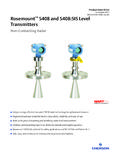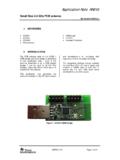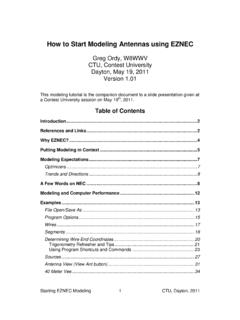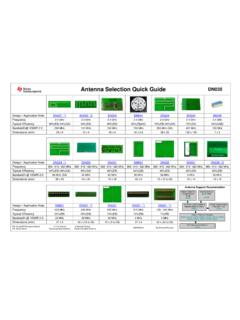Transcription of Antenna Circuit Design for RFID Applications
1 2003 Microchip Technology 1AN710 INTRODUCTIONP assive rfid tags utilize an induced Antenna coilvoltage for operation. This induced AC voltage isrectified to provide a voltage source for the device. Asthe DC voltage reaches a certain level, the devicestarts operating. By providing an energizing RF signal,a reader can communicate with a remotely locateddevice that has no external power source such as abattery. Since the energizing and communicationbetween the reader and tag is accomplished throughantenna coils, it is important that the device must beequipped with a proper Antenna Circuit for successfulRFID Applications .
2 An RF signal can be radiated effectively if the lineardimension of the Antenna is comparable with thewavelength of the operating frequency. However, thewavelength at MHz is meters. Therefore,it is difficult to form a true Antenna for most rfid appli-cations. Alternatively, a small loop Antenna Circuit thatis resonating at the frequency is used. A currentflowing into the coil radiates a near-field magnetic fieldthat falls off with r-3. This type of Antenna is called amagnetic dipole Antenna . For MHz passive tag Applications , a fewmicrohenries of inductance and a few hundred pF ofresonant capacitor are typically used.
3 The voltagetransfer between the reader and tag coils is accom-plished through inductive coupling between the twocoils. As in a typical transformer, where a voltage in theprimary coil transfers to the secondary coil, the voltagein the reader Antenna coil is transferred to the tagantenna coil and vice versa. The efficiency of thevoltage transfer can be increased significantly with highQ circuits. This section is written for RF coil designers and rfid system engineers. It reviews basic electromagnetictheories on Antenna coils, a procedure for coil Design ,calculation and measurement of inductance, anantenna tuning method, and read range in rfid Applications .
4 REVIEW OF A BASIC THEORY FOR rfid Antenna DESIGNC urrent and Magnetic FieldsAmpere s law states that current flowing in a conductorproduces a magnetic field around the conductor. Themagnetic field produced by a current element, asshown in Figure 1, on a round conductor (wire) with afinite length is given by:EQUATION 1:where:In a special case with an infinitely long wire where:Equation 1 can be rewritten as:EQUATION 2:FIGURE 1: CALCULATION OF MAGNETIC FIELD B AT LOCATION P DUE TO CURRENT I ON A STRAIGHT CONDUCTING WIREA uthor: Youbok Lee, Technology currentr= distance from the center of wire 0= permeability of free space and given as 4 x 10-7 (Henry/meter) 1= -180 2=0 B oI4 r--------- 2cos 1cos ()=Weberm2 ()B oI2 r---------=Weberm2 ()WiredLIr0B (into the page)PR 2 1 XAntenna Circuit Design for rfid ApplicationsAN710DS00710C-page 2 2003 Microchip Technology magnetic field produced by a circular loop antennais given by:EQUATION 3:whereThe above equation indicates that the magnetic fieldstrength decays with 1/r3.
5 A graphical demonstration isshown in Figure 3. It has maximum amplitude in theplane of the loop and directly proportional to both thecurrent and the number of turns, N. Equation 3 is often used to calculate the ampere-turnrequirement for read range. A few examples thatcalculate the ampere-turns and the field intensitynecessary to power the tag will be given in the 2: CALCULATION OF MAGNETIC FIELD B AT LOCATION P DUE TO CURRENT I ON THE LOOPFIGURE 3: DECAYING OF THE MAGNETIC FIELD B VS. DISTANCE rI= currentradius of loopdistance from the center of loopa=r= 0= permeability of free space and given as 4 x 10-7 (Henry/meter)Bz oINa22a2r2+()32 ----------------------------------= oINa22------------------ 1r3----- =forr2>>a2 RryIcoilBzPzaXVVo tsin=rr-3B 2003 Microchip Technology 3AN710 INDUCED VOLTAGE IN AN Antenna COILF araday s law states that a time-varying magnetic fieldthrough a surface bounded by a closed path induces avoltage around the loop.
6 Figure 4 shows a simple geometry of an rfid applica-tion. When the tag and reader antennas are in closeproximity, the time-varying magnetic field B that isproduced by a reader Antenna coil induces a voltage(called electromotive force or simply EMF) in the closedtag Antenna coil. The induced voltage in the coil causesa flow of current on the coil. This is called Faraday slaw. The induced voltage on the tag Antenna coil isequal to the time rate of change of the magnetic flux .EQUATION 4:where:The negative sign shows that the induced voltage actsin such a way as to oppose the magnetic flux producingit. This is known as Lenz s law and it emphasizes thefact that the direction of current flow in the Circuit issuch that the induced magnetic field produced by theinduced current will oppose the original magnetic field.
7 The magnetic flux in Equation 4 is the total magneticfield B that is passing through the entire surface of theantenna coil, and found by:EQUATION 5:where: The presentation of inner product of two vectors inEquation 5 suggests that the total magnetic flux thatis passing through the Antenna coil is affected by anorientation of the Antenna coils. The inner product oftwo vectors becomes minimized when the cosine anglebetween the two are 90 degrees, or the two (B field andthe surface of coil) are perpendicular to each other andmaximized when the cosine angle is 0 degrees. The maximum magnetic flux that is passing through thetag coil is obtained when the two coils (reader coil andtag coil) are placed in parallel with respect to eachother.
8 This condition results in maximum induced volt-age in the tag coil and also maximum read range. Theinner product expression in Equation 5 also can beexpressed in terms of a mutual coupling between thereader and tag coils. The mutual coupling between thetwo coils is maximized in the above condition. FIGURE 4: A BASIC CONFIGURATION OF READER AND TAG ANTENNAS IN rfid APPLICATIONSN= number of turns in the Antenna coil = magnetic flux through each turnVNd dt------- =B= magnetic field given in Equation 2S= surface area of the coil = inner product (cosine angle between two vectors) of vectors B and surface area SNote:Both magnetic field B and surface S are vector quantities.
9 B Sd =Tag CoilV = V0sin( t)TagB = B0sin( t)Reader CoilI = I0sin( t)Tuning CircuitReaderElectronicsAN710DS00710C-pa ge 4 2003 Microchip Technology Equations 3 and 5, Equation 4 can be rewrittenas:EQUATION 6: where:EQUATION 7:The above equation is equivalent to a voltage transfor-mation in typical transformer Applications . The currentflow in the primary coil produces a magnetic flux thatcauses a voltage induction at the secondary coil. As shown in Equation 6, the tag coil voltage is largelydependent on the mutual inductance between the twocoils. The mutual inductance is a function of coilgeometry and the spacing between them.
10 The inducedvoltage in the tag coil decreases with r-3. Therefore, theread range also decreases in the same way. From Equations 4 and 5, a generalized expression forinduced voltage Vo in a tuned loop coil is given by:EQUATION 8:where:In the above equation, the quality factor Q is a measureof the selectivity of the frequency of the interest. The Qwill be defined in Equations 43 through 5: ORIENTATION DEPENDENCY OF THE TAG ANTENNAThe induced voltage developed across the loopantenna coil is a function of the angle of the arrivalsignal. The induced voltage is maximized when theantenna coil is placed in parallel with the incomingsignal where = voltage in the tag coili1= current on the reader coila= radius of the reader coilb= radius of tag coilr= distance between the two coilsM= mutual inductance between the tag and reader coils, and given by.















